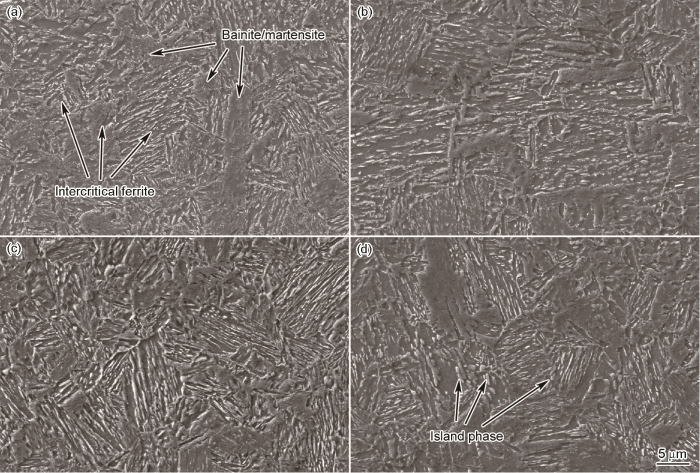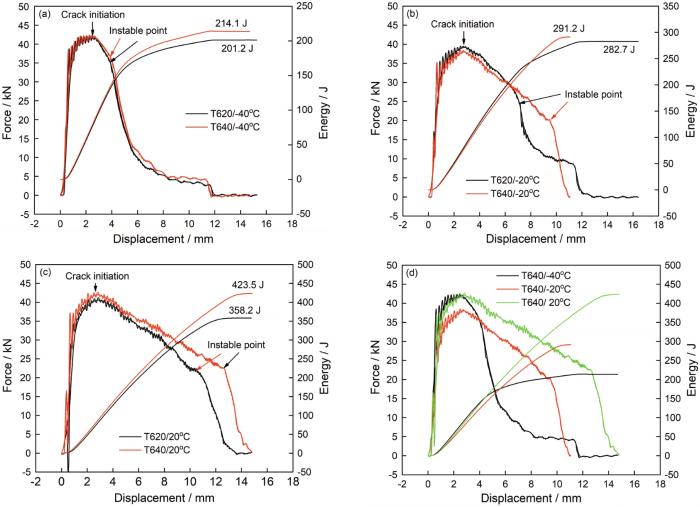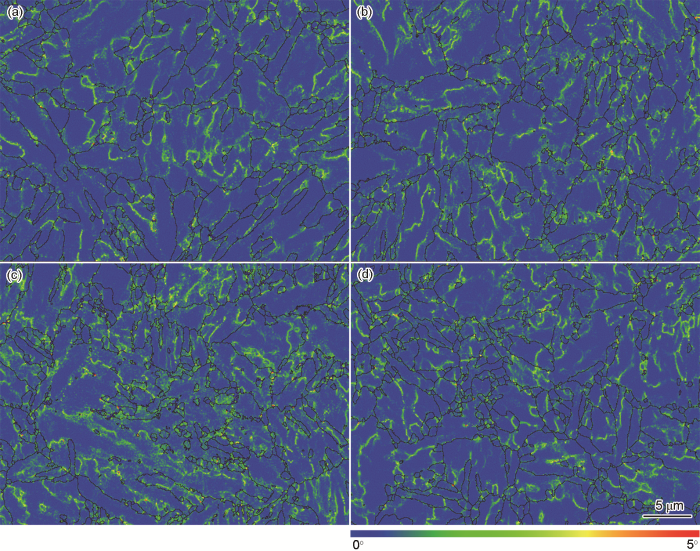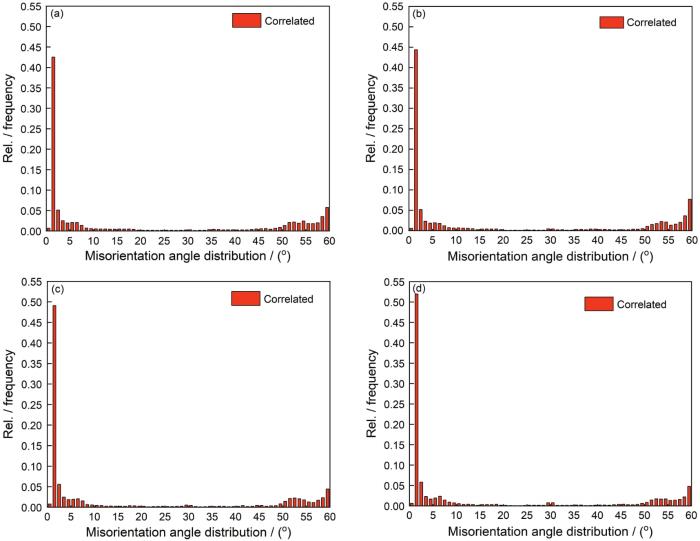在常规的淬火与回火工艺之间增加一步两相区退火,有助于组织间C、Mn元素的再分配,可稳定残余奥氏体[8~11]。用这种工艺,可制备出高体积分数残余奥氏体的低合金化高强钢。同时,伴随着两相区退火形成的贝氏体/马氏体复相组织,兼具马氏体的强度与贝氏体塑性[1,12],实现了强度和塑性的平衡。因此,由残余奥氏体和贝氏体/马氏体组成的多相钢有望成为下一代高性能海工钢[13]。近几年,Zhang[8]和Xi等[14~16]就两相区退火对低碳、低合金海工钢组织及性能的影响以及残余奥氏体的低温韧化机理,进行了深入研究。但是,这些研究侧重于两相区退火工艺与常规的淬火+回火工艺的比较,后续的回火工艺对两相区退火态海工钢组织及性能的影响尚不明确。鉴于此,本文对690 MPa级低碳、低合金海工钢进行淬火+两相区退火+回火三步热处理,采用扫描电子显微镜(SEM)、X射线衍射技术(XRD)、透射电子显微镜(TEM)、常温拉伸与低温冲击等手段研究回火温度对其显微组织、残余奥氏体体积分数及力学性能的影响,并使用示波冲击实验与电子背散射(EBSD)技术探讨残余奥氏体的低温韧化机制和组织演变影响力学性能的机理。
1 实验方法
实验用钢锭用50 kg真空感应炉冶炼,其化学成分(质量分数,%)为:C 0.1,Si 0.42,Mn 2.44,Nb 0.08,Mo 0.30,Ni 1.27,Cu 1.23,Fe余量。将铸锭加热到1200℃并保温2 h,经7道次轧制成25 mm厚钢板。
使用LINSEISL 78 RITA型热膨胀仪测出实验钢的相变起始点温度Ac1为701℃、相变终止点温度Ac3为762℃、Bs: 508℃、Bf: 421℃。为得到均匀奥氏体化组织,先将实验钢加热到830℃保温40 min,随后水淬至室温;再加热至γ:α两相区720℃,保温50 min后出炉空冷至室温。然后分别在580℃、600℃、620℃、640℃进行回火,相应的试样标记为T580、T600、T620、T640。热处理工艺示意图,如图1所示。
图1
图1
实验钢的热处理工艺示意图
Fig.1
Schematic diagram of heat treatment process of the test steel
将回火后的钢板加工成直径为5 mm长度为50 mm的标准拉伸试样,依据GB/T 228B30标准在UTM 5305型电子万能试验机上进行常温拉伸,拉伸速度为1 mm/min。另截取尺寸为10 mm×10 mm×55 mm的V型缺口冲击试样,使用ZBC 2752型冲击试验机进行低温冲击试验。根据GB/T 19748-2005标准,分别在-40℃、-20℃和20℃对T620、T640试样进行示波冲击试验。从不同回火温度的钢板上分别截取尺寸为10 mm×10 mm×10 mm的表征试样,在X`PERTPROX光衍射仪上测定试验钢中的残余奥氏体体积分数;将试样机械研磨抛光后再用10%高氯酸-酒精溶液进行电解抛光,然后用配备Oxford-EBSD插件的JSM 6480LV扫描电镜观察显微组织形貌,并得到试验钢的晶体学信息。将T640试样进行双喷减薄,在JEM-2000场发射透射电子显微镜下观察残余奥氏体的形貌。
2 实验结果
2.1 显微组织
图2给出了试验钢在不同温度回火后的SEM图像,可见其显微组织由回火贝氏体/马氏体、临界铁素体和残余奥氏体组成(在SEM照片中难以区分)[8]。淬火马氏体经过两相区退火后,奥氏体稳定化元素会在组织之间扩散和配分。C、Mn元素会向奥氏体化区域扩散和富集,最终转变为贝氏体/马氏体;而未奥氏体化区域的组织则因C、Mn元素的流失而转变为临界铁素体[17]。实验钢在580℃回火后C、Mn元素进行二次配分,组织间发生逆相变生成残余奥氏体(也称逆转奥氏体),贝氏体/马氏体转变为回火贝氏体/马氏体(图2a)。在此温度下原始奥氏体的晶界仍清晰可见,贝氏体/马氏体板条束也很明显。随着回火温度的提高组织间的C、Mn原子热运动加剧、扩散能力增强,贝氏体/马氏体和临界铁素体由板条状或针状逐步分解为岛状和颗粒状铁素体相,原始奥氏体晶界消失,板条边界模糊(图2b~d)。
图2
图2
在不同温度回火后实验钢的SEM照片
Fig.2
SEM images of the test steel subjected to various heat treatments (a) T580; (b) T600; (c) T620; (d) T640
图3
图3
T640试样中残余奥氏体的TEM照片、在不同温度回火试样的衍射谱和残余奥氏体的体积分数
Fig.3
TEM image of retained austenite in sample T640 (a), XRD spectra (b) and volume fraction of retained austenite (c) for samples treated at different tempering temperature
2.2 力学性能
实验钢在不同温度回火后的力学性能,列于表1。可以看出,随着回火温度的提高屈服强度和抗拉强度逐渐降低。T580试样的屈服强度为787 MPa、抗拉强度为938 MPa。T600试样的屈服强度和抗拉强度略有降低,分别为779 MPa和900 MPa。回火温度提高到620℃屈服强度急剧降低到708 MPa,抗拉强度降低到857 MPa。T640试样与T620试样的屈服强度处于同一水平,抗拉强度则降低到812 MPa。而实验钢的塑性指标则随着回火温度的提高呈增强趋势,伸长率A/%和断面收缩率Z/%分别由T580试样的20.30%、58%提高到T640试样的29.24%、73%。
表1 在不同温度回火后实验钢的力学性能
Table 1
| Sample | Rp0.2 /MPa | Rm /MPa | A /% | Z /% | KV2(-40℃) /J |
|---|---|---|---|---|---|
| T580 | 787 | 938 | 20.30 | 58 | 77 |
| T600 | 779 | 900 | 21.28 | 62 | 104 |
| T620 | 708 | 857 | 24.02 | 68 | 128 |
| T640 | 716 | 812 | 29.24 | 73 | 150 |
低温韧性也随着回火温度的提高而增强。T580试样在-40℃的冲击功仅为77 J,在600℃回火后冲击功升高至104 J,在620℃的冲击功提升至128 J。回火温度为640℃的试样,其冲击功可达到150 J。与图3c对比可知,两相区退火海工钢力学性能的变化与组织中残余奥氏体的体积分数呈线性关系。残余奥氏体的体积分数越高,其塑性和韧性越强,强度越低。尤其对低温韧性的强化效果更显著,与T580相比T640试样的低温韧性提高了近1倍。但是,T620试样中残余奥氏体含量的急剧提高使其屈服强度急剧降低。
3 分析讨论
3.1 残余奥氏体的韧化机制
图4给出了T620和T640试样的位移-载荷与位移-能量曲线,是分别在20℃、-20℃和-40℃下进行示波冲击试验的结果。当试样在-40℃冲击时(图4a),T620和T640试样在裂纹失稳点之前的吸收功相同。低温韧性的差异发生在裂纹失稳扩展-断裂阶段,T640试样在此阶段吸收了更多能量,从而具有更优异的低温韧性。随着冲击温度提高到-20℃(图4b),两者在裂纹稳定扩展阶段都具有较高的裂纹扩展功。但是T620试样随后迅速进入裂纹失稳阶段,承受的冲击载荷急速下降,使总体裂纹扩展功小于更晚进入裂纹失稳阶段的T640试样。其原因是,T640试样内有更高体积分数的残余奥氏体。Chen等[18]认为,薄膜状残余奥氏体的机械稳定性高,受外力撞击时能吸收大量冲击功转变为马氏体。因此,T640试样中高体积分数的残余奥氏体发生了更强烈的TRIP效应,吸收了大量的冲击功,阻碍了裂纹扩展,使材料具有更高的低温韧性[19]。此现象也出现在在20℃冲击的试样中(图4c)。这表明,残余奥氏体的体积分数越高则钢材断裂时可吸收的能量越多,其低温韧性也越高。这些结果,与谢振家等[10]的结论相同。
图4
图4
不同工艺和冲击温度试样的示波冲击位移-载荷和位移-吸收能量曲线
Fig.4
Load and impact energy versus displacement curves of samples at different heat treatment and impact temperature (a) T620 and T640 at -40℃; (b) T620 and T640 at -20℃; (c) T620 and T640 at 20℃ and (d) T640 at -40℃, -20℃ and 20℃
此外,与T640试样在不同冲击温度下的位移-载荷与位移-能量曲线(图4d)的比较发现,冲击温度越低则试样的裂纹稳定扩展阶段越窄,越容易发生裂纹失稳从而发生断裂。其原因是,温度越低则残余奥氏体向马氏体转变的驱动力越大,即残余奥氏体的热力学稳定越差,更容易发生TRIP相变,马氏体组织的增加导致脆性断裂的发生。
3.2 组织演变对力学性能的影响
图5
图5
在不同温度回火后实验钢的局部取向差图
Fig.5
Kernel average misorientation maps of the test steel subjected to various heat treatments (a) T580; (b) T600; (c) T620; (d) T640
图6
图6
在不同温度回火后实验钢的晶界分布
Fig.6
Grain boundary distribution of the test steel subjected to various heat treatments (a) T580; (b) T600; (c) T620; (d) T640
图7
图7
在不同温度回火后实验钢的取向差角分布
Fig.7
Misorientation angle distribution maps of the test steel subjected to various heat treatments (a) T580; (b) T600; (c) T620; (d) T640
4 结论
(1) 经淬火+两相区退火+回火三步热处理后,低碳、低合金海工钢的显微组织是由回火贝氏体/马氏体、临界铁素体和残余奥氏体构成的复相组织。随着回火温度的提高贝氏体/马氏体和临界铁素体逐渐分解为细小的铁素体相,呈岛状或短棒状分布,残余奥氏体的体积分数增加。
(2) 提高回火温度可大大提高两相区退火海工钢的塑性和低温韧性。在580℃~640℃断后伸长率由20.30%增至29.24%,-40℃下的冲击功由77 J提升至150 J,屈服强度则由787 MPa降至716 MPa。性能指标与残余奥氏体的体积分数呈线性关系。
(3) 海工钢中残余奥氏体的体积分数越高断裂时的裂纹扩展功越大,低温韧性越强。冲击温度的降低导致残余奥氏体的稳定性下降,容易发生裂纹失稳和由韧性断裂向脆性断裂的转变。
(4) 贝氏体/马氏体的分解和残余奥氏体的生成使组织细化、晶粒内低KAM值位错的比例提高和出现小角度晶界频率的提高,因此塑性和低温韧性显著提高。
参考文献
Microstructure-property relationship in a high strength-high toughness combination ultra-heavy gauge offshore plate steel: the significance of multiphase microstructure
[J].
New generation of HSLA steels for naval structures
[J].
新一代易焊接高强度高韧性船体钢的研究
[J].
Carbon partitioning into austenite after martensite transformation
[J].
Novel medium-Mn (austenite+martensite) duplex hot-rolled steel achieving 1.6 Gpa strength with 20% ductility by Mn-segregation-induced TRIP mechanism
[J].
Influence of Al on the microstructural evolution and mechanical behavior of low-carbon, manganese transformation-induced-plasticity steel
[J].
Formation of precipitated austenite in 9% Ni steel and its function at cryogenic temperature
[J].
9%Ni钢中沉淀奥氏体的形成过程及其在深冷下的表现
[J].
On the relationship between return austenite and toughness for Ni9 steel at cryogenic temperatures
[J].
Ni9钢中的回转奥氏体与低温韧性
[J].
Effect of film-like retained austenite on low temperature toughness of high strength offshore steel
[J].
Relationship between retained austenite stability and cryogenic impact toughness in 0.12C-3.0Mn low carbon medium manganese steel
[J].
0.12C-3.0Mn低碳中锰钢中残余奥氏体稳定性与低温韧性的关系
[J].
Effect of retained austenite on ductility and toughness of a low alloyed multi-phase steel
[J].
低合金多相钢中残余奥氏体对塑性和韧性的影响
[J].
Regulation of multi-phase microstructure and mechanical properties in a 700 MPa grade low carbon low alloy steel with good ductility
[J].
700 MPa级高塑低碳低合金钢的多相组织调控及性能
[J].
Investigation on tempering of granular bainite in an offshore platform steel
[J].
Thermal and mechanical stability of retained austenite surrounded by martensite with different degrees of tempering
[J].
The role of intercritical annealing in enhancing low-temperature toughness of Fe-C-Mn-Ni-Cu structural steel
[J].
Tailoring mechanical properties of a low carbon Cu-containing structural steel by two-step intercritical heat treatment
[J].
Understanding the role of copper addition in low-temperature toughness of low-carbon, high-strength steel
[J].
New low carbon Q&P steels containing film-like intercritical ferrite
[J].
Correlation between mechanical properties and retained austenite characteristics in a low-carbon medium manganese alloyed steel plate
[J].
The effect of austenitizing temperature on the microstructure and mechanical properties of as-quenched 4340 steel
[J].
Effect of tempering temperature on low angle grain boundaries in Q960 steel
[J].
回火温度对Q960钢小角度晶界的影响
[J].
Measurement of plastic strain of polycrystalline material by electron backscatter diffraction
[J].











